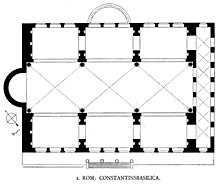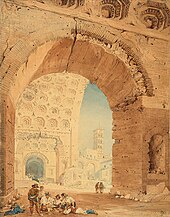Basilica of Maxentius
Constantine I | |
| Founded | AD 312 |
|---|---|
The Basilica of Maxentius and Constantine (Italian: Basilica di Massenzio), sometimes known as the Basilica Nova—meaning "new basilica"—or Basilica of Maxentius, is an ancient building in the Roman Forum, Rome, Italy. It was the largest building in the Forum, and the last Roman basilica built in the city.[1]
History
In ancient Rome, a basilica was a rectangular building with a large central open space, and often a raised apse at the far end from the entrance. Basilicas served a variety of functions, including a combination of a court-house, council chamber and meeting hall. There might be, however, numerous statues of the gods displayed in niches set into the walls. Under Constantine and his successors this type of building was chosen as the basis for the design of the larger places of Christian worship, presumably as the basilica form had fewer pagan associations than those of the designs of traditional Greco-Roman temples,[2] and allowed large congregations. As a result of the building programmes of the Christian Roman emperors the term basilica later became largely synonymous with a large church or cathedral.


Construction began on the northern side of the forum under the emperor
During the 6th century, the building was called "templum Romae".[1]
Architecture
The colour of the building before it was destroyed was white. The basilica stood on a 100-by-65-metre (328 ft × 213 ft) concrete and rectangular platform. The thickness of the platform is not known/communicated.
The building consisted of a central

The south and central sections were probably destroyed by the earthquake of 847.[6][1] In 1349 the vault of the nave collapsed in another earthquake. The only one of the eight 20-metre (66 ft) high columns that survived the earthquake was brought by Pope Paul V to Piazza Santa Maria Maggiore in 1614. All that remains of the basilica today is the north aisle with its three concrete barrel vaults.[3] The ceilings of the barrel vaults show advanced weight-saving structural skill with octagonal ceiling coffers.
On the outside wall of the basilica, facing onto the
Engineering


The basilica Maxentius took aspects from Roman baths as well as typical Roman basilicas. At that time, it used the most advanced engineering techniques known including innovations taken from the
Similar to many basilicas at the time such as the Basilica Ulpia, the Basilica of Maxentius featured a huge open space in the central nave. However, instead of having columns support the ceiling like other basilicas, it was built using arches, a much more common appearance in Roman baths than basilicas. Another difference from traditional basilicas is the roof of the structure. While the former were built with a flat roof, the Basilica of Maxentius featured a folded roof, decreasing the overall weight of the structure and decreasing the horizontal forces exerted on the outer arches.[7]

Legacy
The artist Giovanni Battista Piranesi (1720–1778) drew many etchings of the basilica.[8]
The building became an inspiration for many buildings built afterwards, including New York City's former Penn Station.[9]
See also
- Colossus of Constantine, originally situated in the west apse of the Basilica.
- List of monuments of the Roman Forum
References
- ^ a b c d e Samuel Ball Platner, Basilica Constantini, Uchicago.edu, 1929
- ISBN 978-0073053042.
- ^ ISBN 0-06-430158-3.
- ^ Basilica of Maxentius/Constantine, Mmdtkw.org
- ^ Glory After the Fall: Images of Ruins in 18th- and 19th-Century British Art. Archived 2016-03-04 at the Wayback Machine The Huntington. Retrieved 12 July 2015.
- ^ René Seindal "Basilica of Maxentius - the last and largest basilica in the Roman Forum" Archived 2016-10-21 at the Wayback Machine, Photo Archive, 2003-08-06, accessed November 7, 2010.
- ^ Giavarini, Carlo, The Basilica of Maxentius: the Monument, its Materials, Construction, and Stability, Rome: L'Erma di Bretschneider, 2005.
- ^ Basilica of Maxentius and Constantine: Piranesi, Wellesley.edu
- ^ Basilica of Maxentius and Constantine: Architecture, Wellesley.edu
Sources
- 1960 Summer Olympics official report. Volume 1. pp. 76, 79.
- The Roman Empire: From the Etruscans to the Decline of the Roman Empire, Henri Stierlin, ISBN 3-8228-1778-3
External links
- A reconstruction at the Plan de Rome Archived 2009-03-16 at the Wayback Machine
- High-resolution 360° Panoramas and Images of Basilica of Maxentius | Art Atlas
- ISBN 9780870991790; full text available online from The Metropolitan Museum of Art Libraries
- Lucentini, M. (31 December 2012). The Rome Guide: Step by Step through History's Greatest City. Interlink. ISBN 9781623710088.
![]() Media related to Basilica of Maxentius at Wikimedia Commons
Media related to Basilica of Maxentius at Wikimedia Commons
| Preceded by Basilica of Junius Bassus |
Landmarks of Rome Basilica of Maxentius |
Succeeded by Basilica of Neptune |
